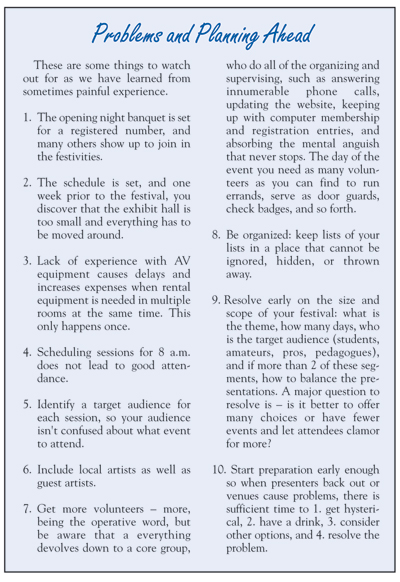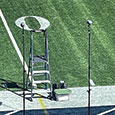Flute clubs throughout the U.S. hold one or two-day festivals each year. The Chicago Flute Club (CFC) held its first two-day festival in 2007, and we learned a lot from that experience. There is a lot involved in planning and organizing a festival, and we thought other clubs might benefit from what we have learned.
Prior to 2007, the CFC had hosted annual single-day events, usually at colleges or high schools. To allow more time for class sessions, keep costs down for exhibitors, and avoid burnout for the members who plan and organize the event, we switched from an annual festival to a biennial two-and-a-half day program. Taking on a project of this magnitude requires careful organization, active volunteers, and a rigorous time-line. Here’s how we did it.
 Two Years Out
Two Years Out
The planning for the 2009 festival began two years ago, immediately after completing the previous one. The members of the committee are responsible for such areas as publicity, programming, volunteers, banquet, corporate sponsorship, judges, and exhib-itors. The first thing they did was establish a budget based upon past experience.
Then we contacted other flute clubs around the country to find out about their festivals. We were particularly interested in the programs that they offered and whether entrance to their festivals was included in members’ annual dues. We discovered that most flute clubs have one-day festivals. Some add an additional fee for members to attend their festival, and some do not. We decided to offer members a reduced rate. Members will pay $55 and non-members $75. However, there are further reductions for early registration and for parents accompanying students, etc.
The Guest Artist
Before choosing a guest artist I made a list of flute clubs around the country and the guest artists and teachers they had used in the past. I wanted to know who was the most popular. Also included on my list were teachers with whom I was impressed. After sorting the list down to a manageable size, I started contacting the artists.
I believe that the first contact with an artist has to be a personal call. Email is just too impersonal. I asked three questions of each: Are you interested? Are you available? and What would you charge? Some sent me to their agent, some quoted a price and asked me not to contact their agent, and others didn’t have an agent and quoted a price on their own.
As luck would have it, we wound up with four artists for 2009, something we generally could not afford. In this case, Matthias Ziegler, Marco Granados, and Dennis Bouriakov offered to come when they learned that William Bennett (Wibb ) would be the Guest Artist and receive the Lifetime Achievement Award. They all studied with Wibb and wanted to be involved as a way of honoring him. The CFC is paying their travel expenses and they have waived their normal artist fees.
The Venue
With Wibb secured, we visited hotels looking for a place that would be convenient for members and visiting flutists and that would be suitable for exhibitors. We considered the amount of space available for exhibitors’ tables, the size and number of meeting rooms, options for audio-visual equipment, the cost of hotel rooms, and portage fees (if any) for the exhibitors’ equipment.
We looked at the ballroom as a possible site for the main performances. There had been a problem in the past that led to a non-budgeted expense for buses to transport festival attendees to another site for concerts, and we wanted to avoid a similar situation in 2009. After much discussion we chose the Hotel Orrington, in Evanston – the first suburb north of Chicago. The hotel is less than two blocks from the Music Institute of Chicago which has a beautiful concert hall. We came to an agreement with them to include our concerts on their season subscription list. We received the use of the hall gratis and potentially may have many more paying guests at the recitals.

Picking a Theme
With the cornerstones of the festival in place and contracts signed, we moved on to the message we wanted to use as the focal point. In 2007 our festival was titled “Our Heritage and Our Promise.” We focused on the great teachers of the flute community and explored how phrasing, articulation, and pedagogy styles have evolved over the years. This year the theme is “Twenty Years and Beyond.” Styles of music have changed radically in the past 20 years, and the schedule of events addresses the interests of various types of musicians.

The Program
One of the most challenging parts of putting a festival together is avoiding overlapped events. We also wanted to have a variety of events for the various types of flutists. By observing the attendance at sessions in 2007, we learned that young students visit the industry exhibits to learn about improving or upgrading their instruments. They also want to learn how to play the big flutes and find out about the technical challenges they will face as they develop. Conservatory-trained musicians and teachers want demonstrations, performances, and information about contemporary techniques in today’s new music. Non-professional flutists wanted to participate in flute choirs, listen to others perform in recitals and competition finals, and observe masterclasses.
Volunteers
While all this planning was going on, we notified our members, nearby flute clubs, and potential exhibitors about the upcoming event. We asked for volunteers with a question on the registration form and on the club’s website. The volunteers do such unsung duties as envelope stuffing, guarding doors, and meeting airplanes.
Exhibitors
The flute industry is an integral part of the success of any festival, and most of the planning was done with them in mind. We also offered them advertising space in the program book, which provides an additional source of income for the festival.
We sent out a save-the-date notice 18 months ago and then followed up with an email. In past years we asked them to choose from various sponsorship levels, but this year we decided not to do that. Exhibitors can pay for an advertisement in the program book if they wish, and donations will be gladly appreciated. Another mailing listed festival activities, estimated attendance figures, and offered a discount for reserving tables by a specific date. The final mailing to exhibitors will be a brochure sent right after the August N.F.A. convention. After that, we have three people assigned to making phone calls.
We hope the 2009 Flute Festival will be exciting, with topics of interest for everyone. It is possible for any flute club to accomplish such an event, provided that you maintain a timetable, have trusty volunteers who follow through on their tasks, remain vigilant about the budget, and foster a continuous connection with your membership to assure attendance. Œ.






